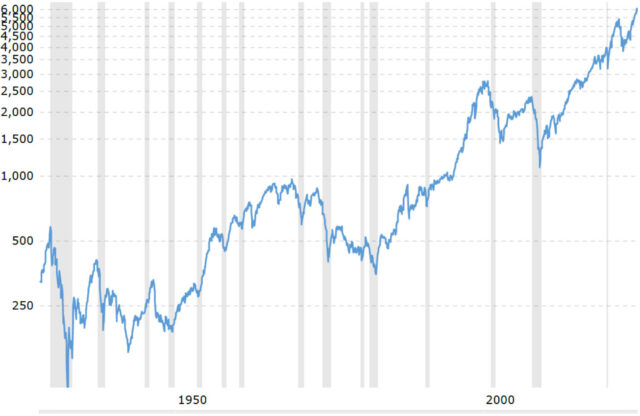The current wild fluctuations of the stock may be causing concerns about your investments. It’s easy to forget about the profits accumulated over time and focus on the losses. You might worry that your retirement is in jeopardy and that you will never make up again. With much uncertainty and the current world in chaos, it is understandable.
The temptation to react emotionally by pulling money out of the market can be strong, but this can create an even bigger challenge: determining when to reinvest. Timing the market rarely works in an investor’s favor, and history has shown that patience and discipline tend to pay off in the long run.
- Focus on Long‐term Growth: Investing in the stock market has historically provided higher long‐term returns, though annual growth is unpredictable. Looking at market performance over several years, portfolios tend to grow more than they would in a savings account.
- This historical S&P Index chart shows returns have never been linear, with many market swings. While the ups and downs can be unpredictable from year to year, looking back over several years usually shows a positive trend. Over time, the good years have outweighed the bad.

S&P500 historical Chart – resource www.macrotrends.net
- For those who are still years away from retirement, diversification helps portfolios weather volatile markets. Staying invested through downturns allows for participation in the eventual recovery.
- If you’re nearing retirement, this may be a good time to start thinking about how your portfolio is structured for withdrawals. Rather than worrying about daily market movements, it’s more important to focus on ensuring that you have the cash flow needed to support your lifestyle. To achieve this, we structure portfolios using a Bucket Approach to provide stability while allowing for long‐term growth. This strategy ensures that different portions of an investment portfolio serve distinct purposes:
- The first bucket serves your spending needs: This portion holds one year or more of your near‐term withdrawals in cash and liquid investments. These are your living expenses (including taxes) minus any income sources, salary, pensions, Social Security or any other reliable income source. Investments in this category typically include U.S. Treasury bills, short‐duration ETFs, and money market funds.
- The second bucket generates income and replenishes the first, using a mix of high‐quality dividend stocks, ETFs, and bonds. A mixture of quality high dividend securities, ETFs and possibly longer term bonds make up this bucket. This bucket also funds any major cash needs.
- The third bucket is invested for long‐term growth, usually with an outlook of 5‐year or longer. The assets in this portion of your portfolio may fluctuate more, as some holdings will be more aggressive, since growing companies and markets rise and fall on a combination of good earnings and investor (or traders) sentiment. Gains taken in this bucket can be reinvested or added to bucket two or one.
The most important factor in any investing is your comfort level. Over the years, we’ve seen markets reach incredible highs—most recent years, as well as in 2000 and 1993—and we’ve also experienced difficult downturns, like in 1982, 2002, and 2009. Through it all, staying the course, keeping positions in strong, growing companies has proven to be a resilient strategy.


